There are several terms in project management terminology that you might run upon. You can struggle to decide which approach will help you complete your project more quickly. However, there is one that is now gaining popularity, and that term is “Agile Project Management.”
What precisely is agile project management, then? You may ask. We will go into the subject of agile project management in this article to help you find the answer to your concern and determine if it is the right method for you.
We hope to be of assistance to you by defining the terms “agile” and “agile project management” and highlighting the potential benefits for your team. Hoping that after reading this article, you will clearly understand what agile project management is and how it functions.
Table of Contents
- What Do The Terms “Agile” and “Agile Project Management” Mean?
- Definition of Agile Project Management
- How Agile Project Management Process Started
- Traditional vs. Agile Project Management
- Why Agile Project Management Is Important?
- How to Implement Agile Project Management Plan
- Conclusion
- Frequently Asked Questions About
What Do The Terms “Agile” and “Agile Project Management” Mean?
Agile is a way of thinking, an iterative process that emphasizes acting right away in the face of constantly changing circumstances. It indicates that you are prepared to act and respond to a challenging situation or a changing environment. The phrase emphasizes swift and prompt action.
It is a way of handling ambiguous circumstances and adapting to change. This way of thinking enables one to comprehend the circumstance, recognize the difficulty, and make an adjustment by acting through innovative solutions and updates.
Definition of Agile Project Management
When it comes to project management, the methodologies may cause you to become confused. “Agile project management” is currently one of the most well-liked project methodologies. Adaptive project completion is at the core of the agile project management project concept. Agile project management also follows values and principles that put people and relationships, collaboration, and adapting to change before tools and following a set plan.
Early and measured action is a proactive strategy to use during a product’s completion process. The agile project management team responds rapidly to obstacles and anticipates their potential occurrence. Agile project management emphasizes adapting to changes more than sticking to a rigid schedule. This enables the project team to adjust to changes rapidly and stops risks from delaying the final product’s production process.
It also allows team leaders and members to anticipate outcomes and prepare for action rather than concentrating on a stated strategy. The staff can collect input and work on changes thanks to this flexibility.
This method enables clients and the project team to swiftly see the impact of their work. Additionally, it makes everyone involved in the collaboration happy because they get a well-tested and detailed result.
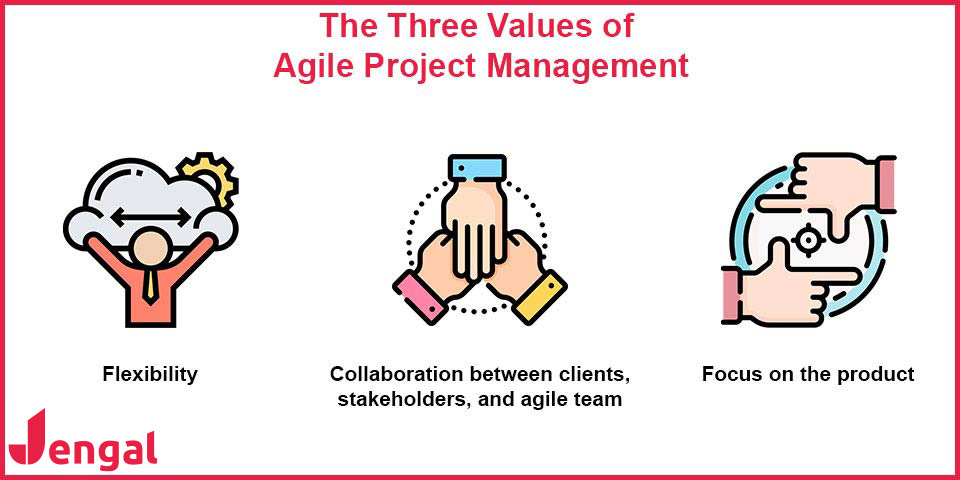
Due to these reasons, if you examine the agile project management values, you will see the three following values:
- Flexibility
- Collaboration between clients, stakeholders, and agile team
- Focus on the product
How Agile Project Management Process Started
Agile was a methodology that project teams adopted in place of conventional methods after it was first announced in 2001. It all began when software engineers became aware of the shortcomings of conventional models and how this led to customer and project team dissatisfaction.
The agile methodology was like breathing fresh air because it was clear that teams were having trouble with the limitations of the traditional approach. It provided the conventional “waterfall model” with a fresh and imaginative perspective.
The waterfall approach has historically included steps including research, design, implementation, testing, and deployment. In contrast to this model, the agile approach stated that there might be more flexibility during the project’s development, testing, and implementation.
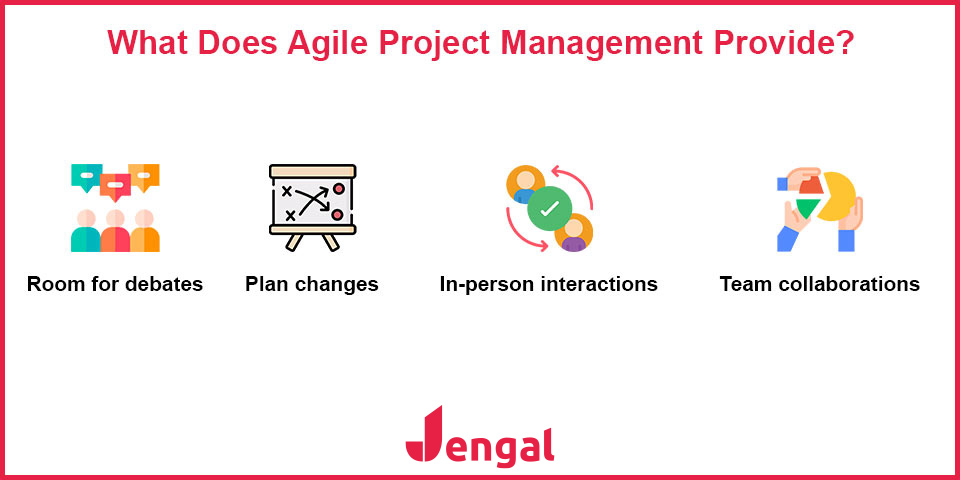
The agile approach allowed each member to actively participate in the project management process. Each team member was able to actively participate from the beginning to the finish of the project, thanks to the agile methodology. It provided room for debates, plan changes, in-person interactions, and team collaborations.
Traditional vs. Agile Project Management
The traditional approach is known as the “waterfall model,” which relies on following specific steps and refraining from starting the next one before finishing the previous one. It entails tasks including information gathering, the design process, implementation, product testing, and deployment.
In contrast to the waterfall model, Agile project management contends that adaptability is essential for a successful product design and deployment. Instead of following a set of steps, the agile approach assigns team members roles in design, testing, implementation, and communication and ensures that there is an interaction between all parties. The project’s success depends on teamwork, whether it comes from stakeholders, clients, or other project team members.
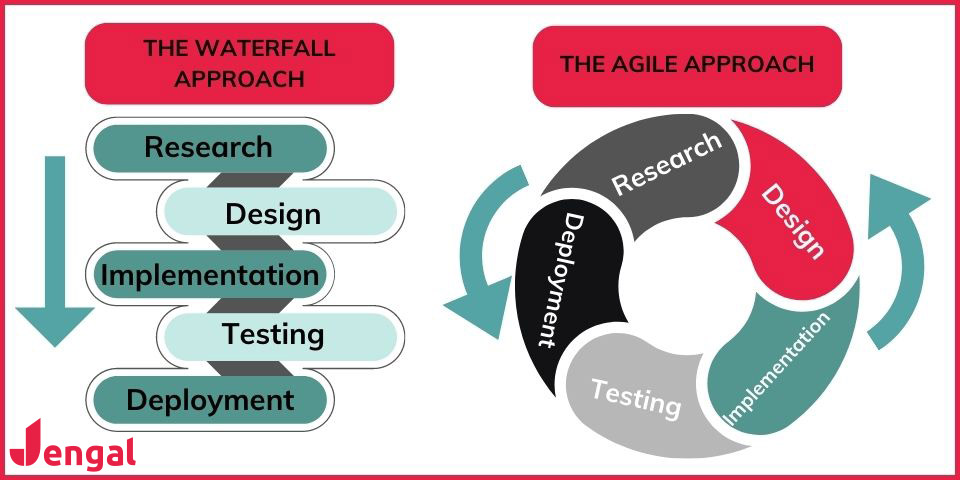
Traditional project management and agile project management have some key differences. If you’re unsure of the nature of these differences, look for the following aspects:
Risk and Control
Because you can’t move on to the next phase without finishing the previous one, and you have less control over each step in the traditional model, it is riskier and takes longer. If a mistake is made, your team could have to start again from scratch.
However, the agile project management approach emphasizes flexibility and increased control. Each team adopts the original strategy and makes the necessary adjustments since they are aware of how their roles relate to one another.
Testing
After the preceding stages are finished, the project team can try testing in the traditional model. However, agile project management enables you to be flexible and test your product frequently to raise its quality.
Feedback
The traditional model might be effective for projects that don’t require feedback, but the agile model might be a superior strategy if you want to get feedback frequently. Agile project management is more open to criticism and adjustments than the traditional methodology is.
Adaptation to Changes and Flexibility
The traditional model is incapable of embracing or adjusting to challenges. According to this approach, it is impossible to make changes to a phase that has already been performed. Unlike the traditional model, the agile model contends that the fundamental components of this strategy are flexibility and adaptability.
Agile project management is crucial, even though the traditional model is still effective and aids in the success of projects that are not complex and require adaptation to changes or feedback.
Why Agile Project Management Is Important?
For the right reasons, you might use the agile methodology for any project you intend to initiate. Even as it is, you might benefit from this. Check out the significant characteristics of agile project management that we have listed below if you’re not sure why you should implement it:
- Short development cycles
- Adapting to changes
- Focus on human interaction
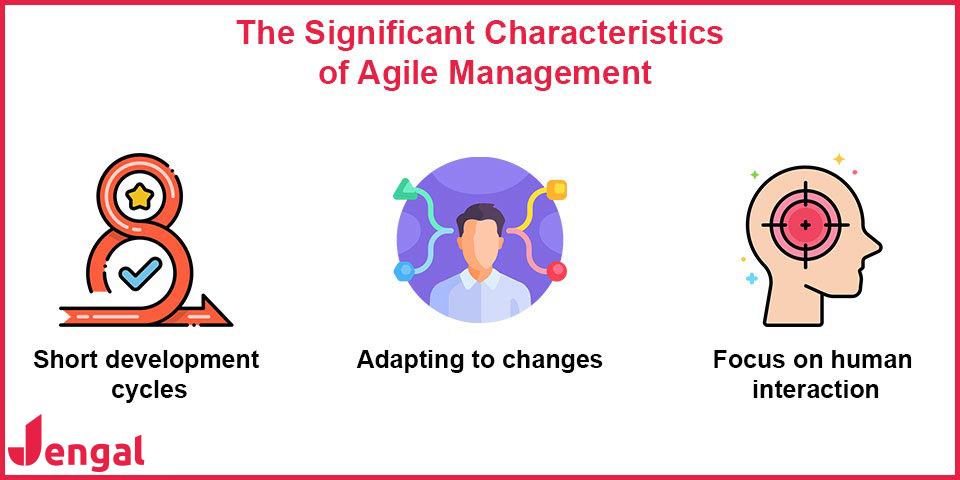
The use of short development cycles, called “sprints,” improves the project team members’ ability to provide and receive feedback frequently and make changes in response to that feedback. By itself, this enables agile project management to adjust to the current business environment’s rapid pace. Agile project management is impacted by the ongoing technological advancements and adjusts to them.
It is crucial for today’s business world because of its capacity to change and adapt to new updates. It adds adaptability and creates space for a massive change. Naturally, these changes wouldn’t be possible without people who are working together.
Human interaction is the primary focus of agile project management. This fact makes it crucial for project managers and team members who value communication and constant feedback. Due to their quick development cycles, the team must interact frequently and create a respectful and trustworthy work environment.
How to Implement Agile Project Management Plan
If you’ve read thus far, you already understand what agile project management is, what its fundamental components are, and why it can be a better strategy for your project. Understanding it and experiencing it in action are two distinct things, however. You could struggle to completely comprehend it if you don’t grasp how it applies to projects.
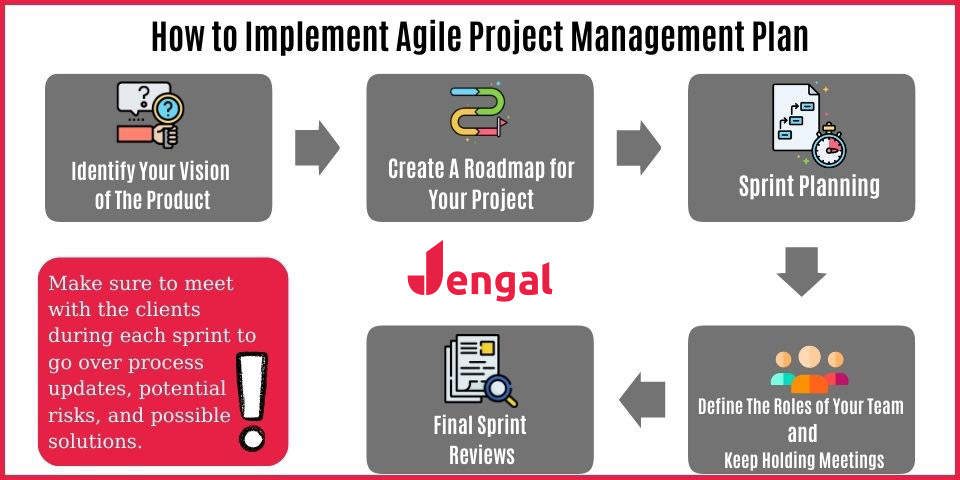
Implementing an agile project management strategy for your company involves five steps. Check the following if you’re unclear about where to begin:
Identify Your Vision of The Product
The first step in putting an agile project management strategy into practice is recognizing the problem and being aware of the client’s expectations. You will have a clear idea of your solution once you know what is expected of you, how you will meet these expectations, and what you will provide.
Artificial intelligence (AI) is a system that enables machines to perform human-like tasks, learn from experience and adapt to new inputs. However, ev...
Software development has become an important and indispensable profession with the advancement of technology day by day. Software goes beyond sectors,...
To decide on the tasks your team will take and to assign roles to the team members, you must have a clear vision for the product you intend to produce. This way, you may comprehend the client’s needs and your product’s future potential.
Create A Roadmap for Your Project
You must develop a plan that outlines your product’s direction once you have identified the issue, found a workable solution, and established a goal. It’s crucial to understand that this roadmap differs from more traditional models.
This roadmap outlines project needs within a loose timeframe rather than planning the creating and delivering process over an extended time. Never forget that the agile method of thinking emphasizes rapid delivery and development. As a result, you can choose the things that need to be accomplished each time while planning.

Sprint Planning
The majority of agile projects are known to be scheduled to be implemented during brief periods known as sprints. Sprints can take a variety of times, although they often last up to 30 days. The success of your project is greatly influenced by how well you and your team plan the sprints before the product development process begins.
Planning your sprints can help you be ready for any potential risks or future developments. It also helps you to improve your team’s efforts to oversee the project and manage changes effectively in the long run.
Define The Roles of Your Team and Keep Holding Meetings
You can assign the roles each team member will perform during each sprint when you meet with the team to decide on the sprints. You may choose which individual is best suited for the team leader position based on their knowledge, particular talents, and independent and unique thinking style.
Remember that the agile project management strategy relies on two-way communication. Even though each team member has a specific responsibility, feedback from other team members and clients will be continuous. For this reason, the project manager should try to maintain a constant level of contact throughout the project’s progress.
Make sure to periodically hold brief meetings during the project development process to reflect on what has been accomplished, what will be done next, and whether any obstacles are slowing progress.
The agile management strategy enables participation from both team members and clients. Make sure to meet with the clients during each sprint to go over process updates, potential risks, and possible solutions.
Final Sprint Reviews
Delivering products to clients marks the conclusion of each sprint. There will be a final spring review on what was accomplished, what kind of obstacles were encountered, and what modifications were made over the working period once your product development process is finished.
Remember to record your last sprint meeting so you may send it to the project team, management, and stakeholders. Understanding that you shouldn’t jump right into the following spring is vital. Evaluation of the one that is completed first and discussion of potential outcomes may be more beneficial in this situation.
Conclusion
In conclusion, we’ve focused on the meanings of the terms “agile” and “agile project management” in this article. We have explained how agile project management works and tried to differentiate it from other methodologies by talking about the topic of traditional vs. agile project management. Additionally, we have emphasized its importance by looking into the aspects of agile project management.
Therefore, we hope this article has helped you better understand what agile project management is and has assisted you in determining whether it is the best approach for your team. Given that traditional approaches are no longer used in today’s market, we think agile project management might be a superior strategy for you and your team. If you are interested in such articles, you can check our What is System Software article.




No comments to show.